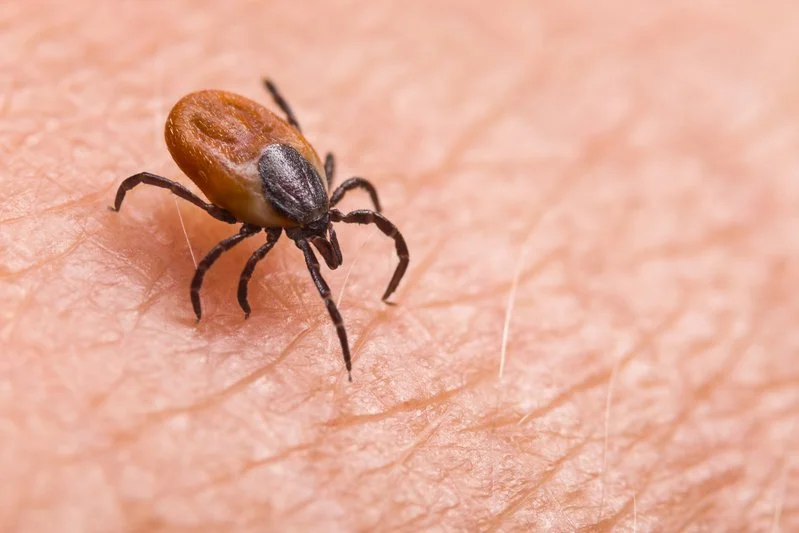May is Tickborne Disease Awareness Month: Comprehensive Resources from the City of Cincinnati Health Department Division of Epidemiology
It has been a very busy spring for communicable disease prevention and control. This month we wanted to take the time to spread Tickborne Disease Awareness, as Ohio and other states in the Midwest have seen the number of cases of Lyme Disease and other tickborne diseases rise dramatically in the last few years. In 2023 Ohio Department of Health reported 1,297 cases meeting the case definition of Lyme Disease. This was 2.18 times as many cases as were counted in 2022 (593). Lyme Disease that is not detected early and treated with the correct antibiotics may lead to more severe and chronic manifestations of the disease as the bacteria disseminates through the body and ultimately a lower quality of life for the patient, and that is a why we think it is so important to emphasize Lyme Disease prevention and early detection.
Symptoms of Lyme Disease can be confusing
When you have a patient with history of a tick bite and new onset of fever and or rash, please consider the diseases that ticks carry and the early signs and symptoms.
Early Localized Symptoms of Lyme Disease: 3 days - 30 days after bite from an infected black-legged tick (aka "deer tick") -
The tell-tale erythema migrans (EM) rash does not appear in every patient with Lyme Disease (60-80%), and is easily missed when hidden by hair, tattoos, and/or darker complexions, but when it does and it is greater than or equal to 5 cm in size across its largest diameter, this is considered clinical confirmation of Lyme Disease and should be reported to the local health department.
Other symptoms may include fever, chills, malaise, fatigue, headache, myalgia, arthralgia, headache and lymphadenopathy.
Disseminated or Late Manifestations of Lyme Disease: Days to months after the bite of an infected tick (sometimes one of these are the chief complaint that brings a patient to the doctor, when initial fever and other early symptoms are not acted on).
Multiple EM rashes, Bell's palsy, Lyme carditis, oligoarticular arthritis, migratory pain in tendons, bursae, muscle and bones, are a few examples.
FREE Provider Resources!
The Centers for Disease Control (CDC) is offering more resources for healthcare providers including:
Upcoming Cincinnati Children’s Coffee with Colleagues: Tickborne Diseases presented by Dr. Elizabeth Schlaudecker Thursday, June 20th from 7-7:45am - Register Here
Pediatric Consult Consult on Tickborne Illness - featuring Dr. Elizabeth Schlaudecker on Apple Podcasts, Google Podcasts, and Spotify
FREE Continuing Education Credits for Tickborne Disease courses and webinars: Tickborne Disease Continuing Education | Ticks | CDC
Free downloadable Reference Manual for Healthcare Providers and other communication resources: Tickborne Diseases of the United States | Tick-borne Diseases | Ticks | CDC
Free wall posters with EM rashes photographed on various skin tones and colors (up to 5 can be ordered):CDC Publications On Demand : Wall poster: The Many Forms of Lyme Disease Rashes (Erythema Migrans) [18x24 in.]
Detailed webpages for Tickborne Diseases inside and outside of the United States: Diseases Transmitted by Ticks | Ticks | CDC
A Tick Bite Bot that can provide guidance to patients when embedded on healthcare websites: Tick Bite Bot | Ticks | CDC
ODH Tickborne Disease resources and surveillance: Tickborne Diseases in Ohio | Ohio Department of Health
Diagnosis v. Surveillance
Case definitions including confirmatory and supportive laboratory evidence are attached to this email for your reference. Another useful guide shared by CDC on Diagnosis and Testing | Lyme Disease | CDC is: Suggested Reporting Language, Interpretation and Guidance for Lyme Disease Serologic Testing Results (aphl.org)
What to do with ticks that are removed?
It is always helpful to know what diseases the patient could have been exposed to, and so we would recommend that the patient/provider safely remove a tick as soon as able, and to save the tick in a plastic bag or take photos of the tick front and back and keep these available for reference should fever and/or rash develop afterwards. This can help guide which tests you might run on a patient in the early stage of disease, because different ticks carry different types of diseases. Same is true for pets! It is helpful for the veterinarian to know which type of tick bit the pet when considering symptoms. We also continue to have tick identification kits if needed to send ticks to ODH for identification purposes. For patients who frequently hike or work near tick habitats, it is also helpful to keep a tick removal kit in the car or with them containing tweezers, an alcohol wipe, and small plastic bag, as well as tick repellant sprays to apply as needed.

